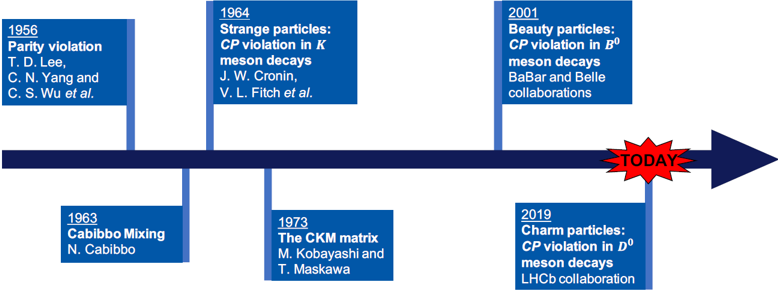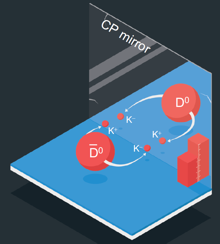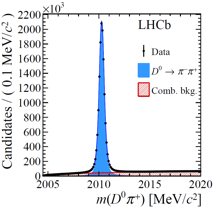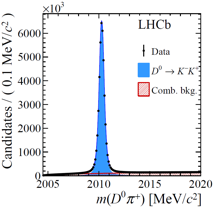An important milestone in the history of particle physics.
[ ΔACP = (-0.154±0.029)% ]
The LHCb collaboration has just presented at the Rencontres de Moriond EW and in a special CERN Seminar the first observation of CP violation in charm particle decays. Quarks can be split into two sectors: those with the same electrical charge as the up quark (up-type quarks, charge +2/3), and those with the same as the down quark (down-type quarks, charge -1/3). Differences in the properties of matter and antimatter, arising from the so-called phenomenon of CP violation, had been observed in the past using the decays of K and B mesons, i.e. of particles that contain strange or beauty quarks, which are both down-type quarks. By contrast, despite decades of experimental searches, CP violation in the decays of charmed particles, i.e. containing the charm quark, which is an up-type quark, escaped detection so far. The result announced today constitutes the first observation of CP violation in decays of a charmed particle.
CP violation is one of the key ingredients required to explain why today’s universe is only composed of matter particles, with essentially no residual presence of antimatter. The phenomenon was first observed in 1964 in the decay of neutral K mesons, and the two physicists who made the discovery, James Cronin and Val Fitch, were awarded the Nobel Prize in physics in 1980. Such a discovery came as a great surprise at the time, as it was firmly believed by the community of particle physicists that the CP symmetry could not be violated. In the early 1970s, building on the foundations laid by Nicola Cabibbo and others some years before, Makoto Kobayashi and Toshihide Maskawa realised that CP violation could be included naturally in the theoretical framework that we know today as the Standard Model of particle physics provided that at least six different quarks existed in nature. Their fundamental idea was confirmed eventually three decades later by the discovery of CP violation in beauty particle decays by the BaBar and Belle collaborations, leading to the award of the 2008 Nobel Prize in physics to Kobayashi and Maskawa. In the Standard Model, the existence and overall size of CP violation are determined by a single parameter, though the way it manifests in a particular decay is influenced by several others. The values of these fundamental parameters can be determined experimentally by measuring many different CP-violating processes. The combined set of these measurements, many of which have been performed by LHCb, agree very well with the Standard Model predictions for all CP-violating effects known so far in particle physics. The Standard Model also predicts a tiny amount of CP violation in charm particle decays, at a level that is difficult to calculate exactly but could be up to 10-3 – 10-4 in decay modes of interest.
LHCb physicists studied the differences in decay rates of neutral D0 mesons, composed of a charm quark (c) bound by strong interactions with an up antiquark (u), and D0 mesons, composed of a charm antiquark (c) bound with an up quark (u). The goal of the analysis is to measure the difference between the decay rates of D0 and D0 mesons decaying into K+K– pairs or into π+π– pairs. In practice, the measurement consists in counting the numbers of D0 and D0 mesons decaying into K+K– or π+π– pairs which are present in the data sample recorded by LHCb in 2011-2018. The LHCb experiment collected an unprecedented amount of such charm decays, allowing physicists from the LHCb collaboration to pinpoint the tiny size of CP violation in the charm-quark sector. However, these decays are identical for D0 and D0 mesons: how can you tell if the decaying meson is D0 or D0 to understand whether there are more D0 or D0 mesons decaying to K+K– (or π+π–) pairs?
To answer this question LHCb physicists exploited two different classes of decays:
a) D0 and D0 mesons are produced from D*+(-) meson decays, D*+ → π+D0 and D*- → π–D0. The presence of a π+ at this point in the decay chain indicates the presence of a D0 meson, whereas a π– accompanies a D0 meson.
b) D0 and D0 mesons are produced from so-called semileptonic beauty decays, as for example B+ → μ+νD0 or B– → μ–νD0. In this way, the presence of a μ+ identifies a D0 meson, whereas a μ– indicates a D0.
The images show the so-called invariant-mass distributions used to count the number of decays that are present in the data sample. The area of each blue, bell-shaped (Gaussian) peak is proportional to the number of decays of that type recorded by the experiment. The final result, which uses essentially the full data sample collected by LHCb so far, is given by the quantity ΔACP=(-0.154±0.029)%, whose difference from zero quantifies the amount of CP violation observed. In particular, this turns out to differ from zero by 5.3σ (5.3 standard deviations), thus surpassing the threshold of 5σ adopted by particle physicists to assert without reservation that a discovery is made. This represents the first observation of CP violation in charm particle decays, opening up a new field in particle physics: the study of CP-violating effects in the sector of up-type quarks, and searches for new physics effects using charm CP asymmetry measurements.
Read more in the Moriond EW presentation, in the CERN seminar presentation, in the LHCb paper, in the CERN Press Release in English end French, in The Conversation article.




